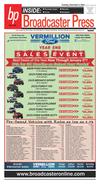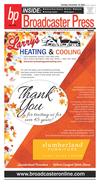092617_YKBP_A14.pdf






September 26, 2017 www.broadcasteronline.com
14 Broadcaster Press
2017 South Dakota Report
Card to be released
South Dakota Supreme
Court Issues Important
Decision on Fairness Tax for
South Dakota Retailers
9
3 6
2
5
5 7
1
9
3
PIERRE, S.D. – Attorney General Marty Jackley announces
the State of South Dakota is one step closer to bringing tax
fairness to South Dakota retailers which would continue to
sustain South Dakota’s status as an income tax-free state.
The State Supreme Court agreed with Attorney General
Jackley that, despite changing times, the Court was obligated
to rule in favor of the defendants in State of South Dakota
v. Wayfair, Overstock and Newegg. Significantly, the Court’s
swift decision recognizes that “as internet sales have risen,
state revenues have decreased.” The Court further highlighted the need for the U.S. Supreme Court to revisit this issue,
allowing states to require internet retailers to shoulder the
same tax burden as in-state retailers do.
“The retail landscape significantly changed with the inception of the internet and access to online shopping. Federal
law currently shields out-of-state businesses from paying the
same tax remitted by South Dakota businesses. Today’s decision paves the way to respectfully request by KrazyDad
Intermediate Sudoku Puzzles the U.S. Supreme
Court to provide that much needed fairness to save main
streets and jobs across South Dakota,” said Jackley.
The prevailing law, as set forth in Quill Corp v. North
Sudoku #2
Dakota, 504 U.S. 298, 112 S. Ct. 1904 (1992), provides that a
state cannot require retailers who do not5 a “physical
have
1
8
presence” in the state to collect and remit the state sales tax.
The purpose of South Dakota’s current litigation is to give
2
5 9 1
the United States Supreme Court an opportunity to reconextraordinary growth7 the internet
of
1 sider Quill in light of the 3
and the exponential technological advances that have been
century. If the U.S. Supreme Court
3 made in the last quarter 1
3
ultimately strikes down Quill, retail sales tax obligation can
be applied fairly to both internet and main street businesses.
This case stems from a state law passed in 2016 that
9
would require4
out-of-state retailers to collect and remit the
sales tax similar to in-state retailers. The law applies to
8 out-of-state retailers if they have more than $100,000 of sales
9
2
or complete more than 200 sales transactions a year within
2
South Dakota.3 7 4
© 2008 KrazyDad.com
bpp
b
Since 1934
Since 1934
6
1
8
B
roadcaster
Broadcaster Press
© 2008 KrazyDad.com
Press
Fill the puzzle so that every row, every column, and every
section contain the numbers 1-9 without repeating a number.
Sudoku #4
5
roadcaster 5
bp B2 8
9
bp B
5
Press
roadcaster
Since 1934
7
Press
2
Since 1934
4
7
rs
9
3
9
7 3 9 5
4 9 6 7
5 1 2 3
8 5 1 6
6 4 8 2
3 2 4 9
1 8 5 4
2 7 3 1
9 6 7 8
1
5
8
4
3
5 7
1 6
6
7
5
8
9
© 2008 KrazyDad.com
6
2
Sudoku #2
2 8 6 7 9 4 5 1
5 7 1 2 3 6 8 9
3 9 4 5 8 1 7 2
1 2 8 6 7 3 4 5
9 6 3 4 1 5 2 8
7 4 5 8 2 9 6 3
8 1 2 3 4 7 9 6
6 3 7 9 5 2 1 4
intermediate
4 5 9 1 6 8 3 7
4
9 76
1
3
2
9
5
8
2
Last tuesday’s
6 8
4 1
7 5
9 4
5 2
3 7
4 1 7 5 6
Sudoku #6
4 6 8 2 3
9
6
4
6
4
6
2 9 4
5 7 6
3 8 1
1 4 6 5 9
6 3 7 1 8
9 7 4 2 3
4 8 9 6 2
5 2 8 3 7
3 9 1 4 5
8
3
8
1
3
Sudoku Solution
#4
5 8 4 9 6 1 7
9 1 7 4 2 3 5
3 6 2 5 8 7 4
4 3 1 7 9 5 2
7 5 8 2 3 6 9
2 9 6 1 4 8 3
6 7 5 3 1 2 8
1 4 3 8 7 9 6
8 2 9 6 5 4 1
2 1
7 5
3
Easy Sudoku Puzzles by KrazyDad
8
1
7
3 9
1 5
© 2008 KrazyDad.com
int BOOK 64 #4
su do ku
KRAZYDAD.COM/PUZZLES
8 6
1
7
2
3
1
9
5
© 2008 Krazydad.com
Check next tuesday’s paper for
the solution to today’s puzzle.
EA BOOK 64 #4
ABERDEEN, S.D. – At its meeting Sept. 18, the South Dakota Board of Education Standards heard state-level results
from the 2017 Report Card. The Report Card uses several
indicators to measure how schools are performing.
“With the advent of the Every Student Succeeds Act,
states have the opportunity to broaden the measures they
use to review school performance,” said Laura Scheibe,
deputy director of accountability systems for the Department of Education. “In South Dakota, we are working toward
an accountability system that supports our aspiration that
all students leave the K-12 system college, career and life
ready.” She expects that, in coming years, the indicators
that make up the state’s accountability system will continue
to grow.
This year’s Report Card encompasses indicators such as
student achievement, academic growth, attendance rates,
high school completion, and college and career readiness.
“From a big-picture perspective, we are on the right trajectory,” Scheibe said. Many of the indicators of performance
from the 2016-17 school year remained steady or increased.
For example, the percentage of students scoring proficient (at or above Level 3) on the state math test increased
by two percentage points in 2017. Another bright spot is the
performance of the state’s English learners. This group of
students saw a significant increase in proficiency rates on
the state test – moving more than three percentage points in
both math and English language arts.
In recent months, educators and lawmakers around
the state have been engaging in conversations about how
to better connect K-12 education with the world of work,
and how to engage students early on in career exploration.
The annual Report Card encompasses certain indicators
designed to measure some of these connections.
According to the Report Card, 25 percent more students
took the National Career Readiness Certificate assessment
in 2017 than 2016. This test focuses on skills necessary for
success in the workforce. Even with these additional students, performance on the NCRC remained strong. Just over
94 percent earned a “Bronze” certification, compared to 92
percent last year. “The fact that we have more students taking the NCRC, which is voluntary, indicates that our schools
are interested in making connections between students and
the workforce,” Scheibe said.
Finally, while the college readiness indicator showed
a decline, more students are being incorporated into this
measurement than ever before. Previously, this indicator
was based solely on ACT scores; this year, it includes ACT,
Accuplacer and Smarter Balanced scores. “Using ACT alone
was limiting in terms of the information it was providing,
since not all students take the ACT. This new measure more
accurately reflects how our schools are doing in preparing
students for that next step, whether that’s a four-year college, a technical school or an industry-based certification
program,” Scheibe said.
The 2017 Report Card can be accessed by visiting www.
doe.sd.gov and clicking on the “2017 Report Card” banner.
Another Tool To Enhance Water Quality
By Mike Jaspers
South Dakota Secretary of Agriculture
In South Dakota, we have a long legacy of working
together to both produce food for the world and protect
and enhance our natural resources, from the soil we use for
crops and grass to the water we fish in, swim in and drink.
I recently had the privilege of attending a ceremony at the
Sioux Empire Fair where the seven millionth acre in South
Dakota was enrolled in the Conservation Stewardship Program. More acres are enrolled in the Conservation Stewardship Program in South Dakota than in any other state in the
nation. This is a great milestone for a program that does
so much to help producers implement practices on their
cropland and pastures that will enhance and protect South
Dakota’s natural resources while at the same time allowing
them to grow their crops and raise their livestock.
This year there is an additional program available to
South Dakota producers to help them protect water quality
in the state. The new buffer strip incentive program offers
producers a decrease in their property taxes if they put in
and maintain buffer strips on numerous bodies of water in
our state. Buffer strips are areas of vegetation that border
waterbodies and trap sediment and other runoff to prevent
them from entering a waterbody. Under this program, producers, or other landowners, can be eligible for a 40 percent
discount on their property tax if they install and maintain a
buffer strip, between 50 and 120 feet wide that is planted to
perennial vegetation, along an eligible lake, river or stream.
The buffer strip can still be used for certain activities, such
as haying and grazing, during certain periods throughout
the year.
To enroll in this program, producers will have to fill out
an application and send it to the director of equalization
in the county they file property taxes in. The South Dakota
Department of Revenue has a copy of an application that
producers can download and fill out, as well as contact information for directors of equalization in South Dakota, on
their website. Additionally, the South Dakota Department of
Environment and Natural Resources has developed a helpful tool that allows landowners to view and download maps
of the 575 eligible lakes and 11,000 miles of eligible streams.
The map can also be used to estimate buffer strip lengths
and acres. Links to both the application and map can be
found on the South Dakota Department of Agriculture’s
homepage, http://sdda.sd.gov/.
As a producer, I work hard every day to leave our state
better than I found it. I know that my neighbors and producers across the state do the same. This program, particularly
when used in conjunction with other programs like the Conservation Stewardship Program, is an additional tool to help
producers remain good stewards of our natural resources
and a reason for South Dakotans to celebrate.

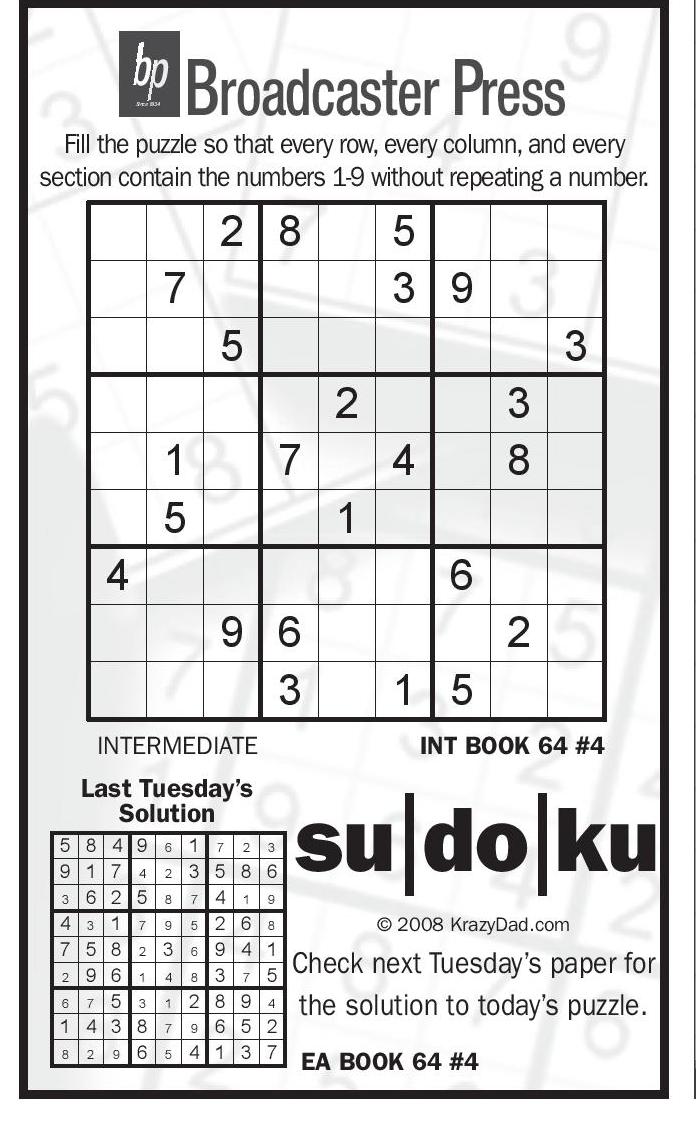
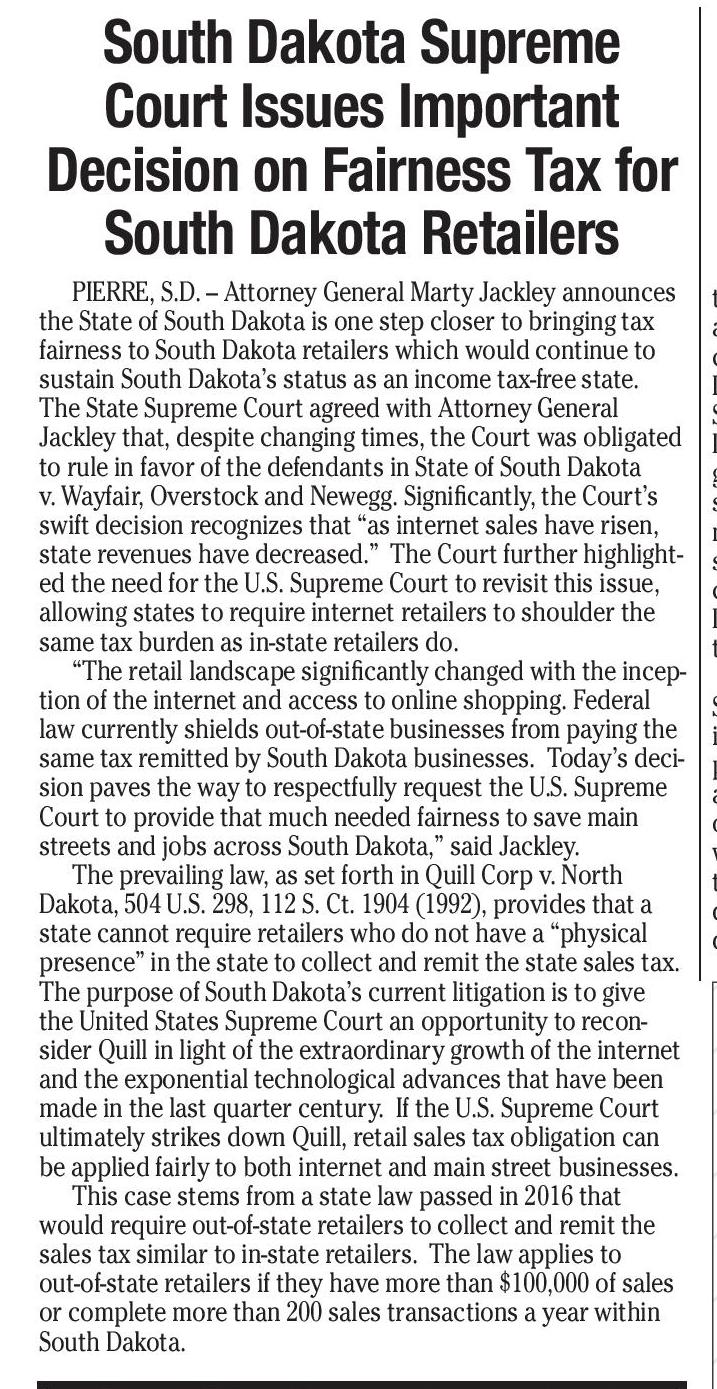

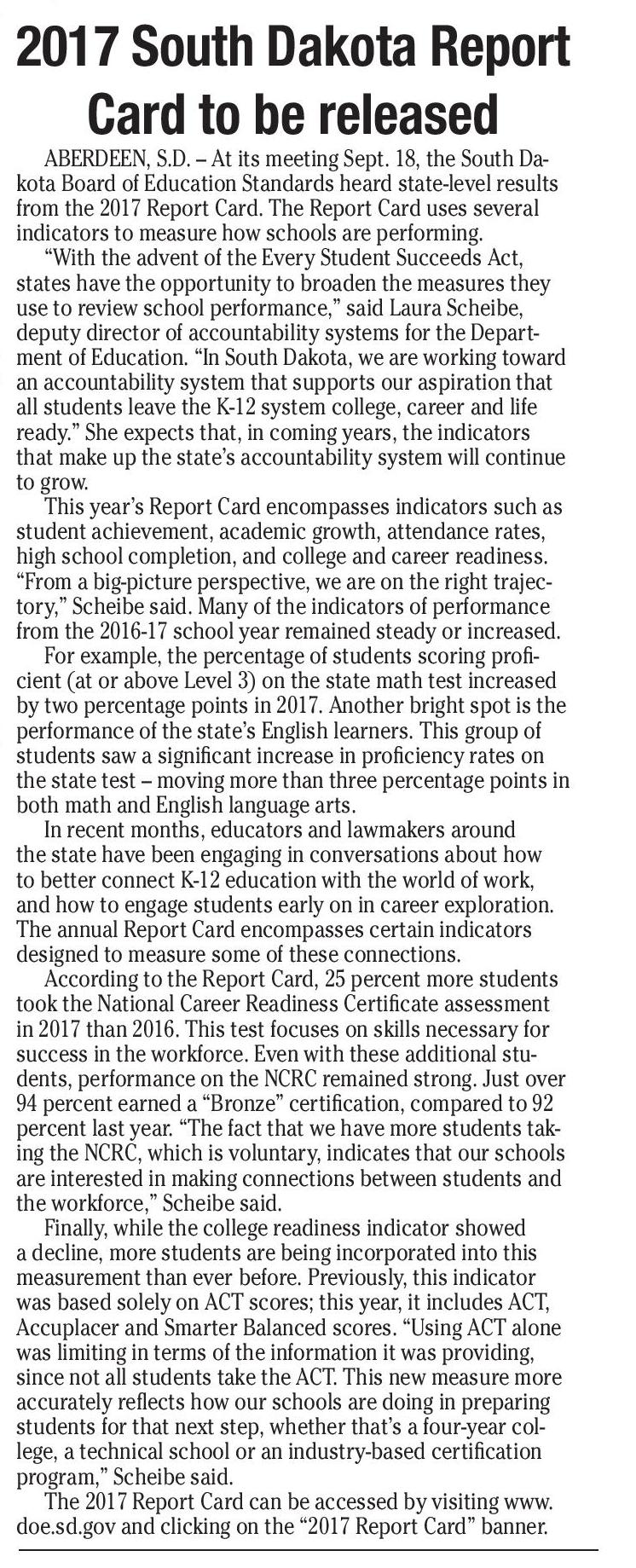



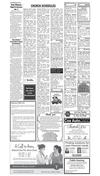
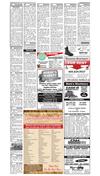

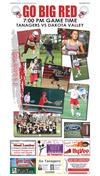
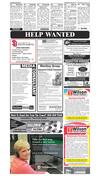



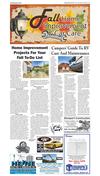
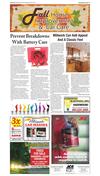



 Previous Page
Previous Page


